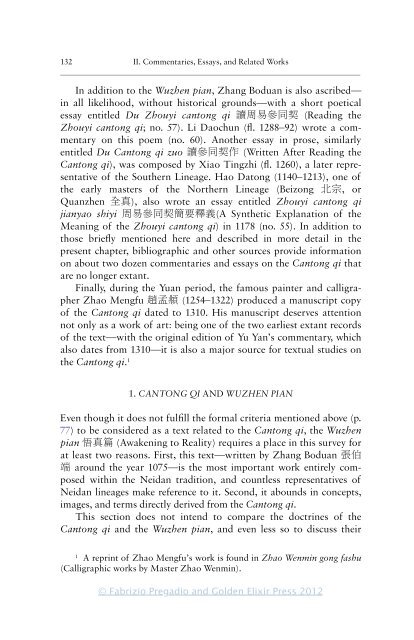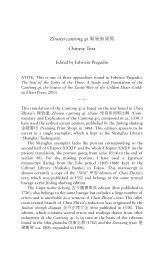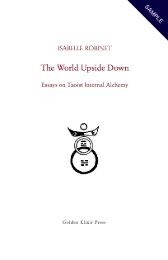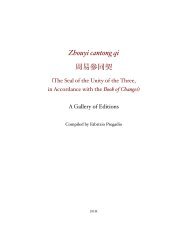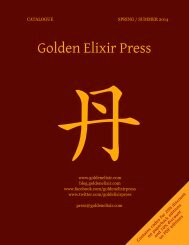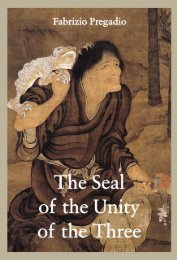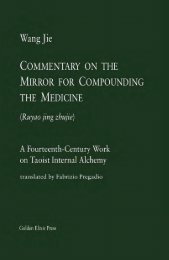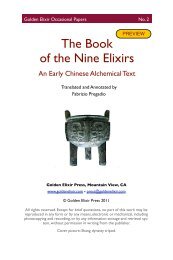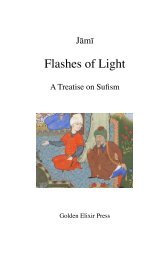The Seal of the Unity of the Three â Vol. 2 - The Golden Elixir
The Seal of the Unity of the Three â Vol. 2 - The Golden Elixir
The Seal of the Unity of the Three â Vol. 2 - The Golden Elixir
- No tags were found...
You also want an ePaper? Increase the reach of your titles
YUMPU automatically turns print PDFs into web optimized ePapers that Google loves.
132 II. Commentaries, Essays, and Related Works<br />
—————————————————————————————————————————<br />
In addition to <strong>the</strong> Wuzhen pian, Zhang Boduan is also ascribed—<br />
in all likelihood, without historical grounds—with a short poetical<br />
essay entitled Du Zhouyi cantong qi 讀 周 易 參 同 契 (Reading <strong>the</strong><br />
Zhouyi cantong qi; no. 57). Li Daochun (fl. 1288–92) wrote a commentary<br />
on this poem (no. 60). Ano<strong>the</strong>r essay in prose, similarly<br />
entitled Du Cantong qi zuo 讀 參 同 契 作 (Written After Reading <strong>the</strong><br />
Cantong qi), was composed by Xiao Tingzhi (fl. 1260), a later representative<br />
<strong>of</strong> <strong>the</strong> Sou<strong>the</strong>rn Lineage. Hao Datong (1140–1213), one <strong>of</strong><br />
<strong>the</strong> early masters <strong>of</strong> <strong>the</strong> Nor<strong>the</strong>rn Lineage (Beizong 北 宗 , or<br />
Quanzhen 全 真 ), also wrote an essay entitled Zhouyi cantong qi<br />
jianyao shiyi 周 易 參 同 契 簡 要 釋 義 (A Syn<strong>the</strong>tic Explanation <strong>of</strong> <strong>the</strong><br />
Meaning <strong>of</strong> <strong>the</strong> Zhouyi cantong qi) in 1178 (no. 55). In addition to<br />
those briefly mentioned here and described in more detail in <strong>the</strong><br />
present chapter, bibliographic and o<strong>the</strong>r sources provide information<br />
on about two dozen commentaries and essays on <strong>the</strong> Cantong qi that<br />
are no longer extant.<br />
Finally, during <strong>the</strong> Yuan period, <strong>the</strong> famous painter and calligrapher<br />
Zhao Mengfu 趙 孟 頫 (1254–1322) produced a manuscript copy<br />
<strong>of</strong> <strong>the</strong> Cantong qi dated to 1310. His manuscript deserves attention<br />
not only as a work <strong>of</strong> art: being one <strong>of</strong> <strong>the</strong> two earliest extant records<br />
<strong>of</strong> <strong>the</strong> text—with <strong>the</strong> original edition <strong>of</strong> Yu Yan’s commentary, which<br />
also dates from 1310—it is also a major source for textual studies on<br />
<strong>the</strong> Cantong qi. 1 1. CANTONG QI AND WUZHEN PIAN<br />
Even though it does not fulfill <strong>the</strong> formal criteria mentioned above (p.<br />
77) to be considered as a text related to <strong>the</strong> Cantong qi, <strong>the</strong> Wuzhen<br />
pian 悟 真 篇 (Awakening to Reality) requires a place in this survey for<br />
at least two reasons. First, this text—written by Zhang Boduan 張 伯<br />
端 around <strong>the</strong> year 1075—is <strong>the</strong> most important work entirely composed<br />
within <strong>the</strong> Neidan tradition, and countless representatives <strong>of</strong><br />
Neidan lineages make reference to it. Second, it abounds in concepts,<br />
images, and terms directly derived from <strong>the</strong> Cantong qi.<br />
This section does not intend to compare <strong>the</strong> doctrines <strong>of</strong> <strong>the</strong><br />
Cantong qi and <strong>the</strong> Wuzhen pian, and even less so to discuss <strong>the</strong>ir<br />
1<br />
A reprint <strong>of</strong> Zhao Mengfu’s work is found in Zhao Wenmin gong fashu<br />
(Calligraphic works by Master Zhao Wenmin).<br />
© Fabrizio Pregadio and <strong>Golden</strong> <strong>Elixir</strong> Press 2012


